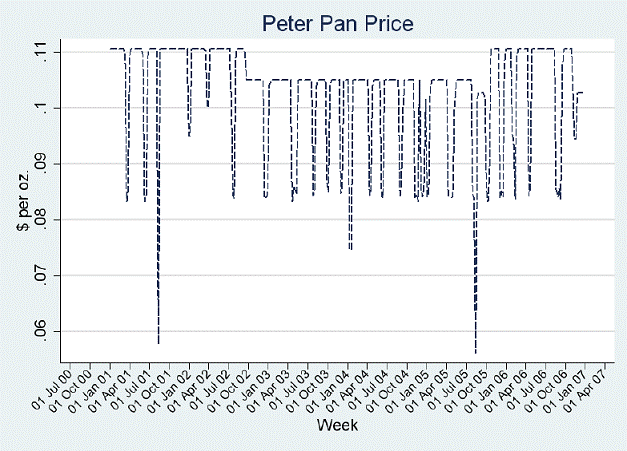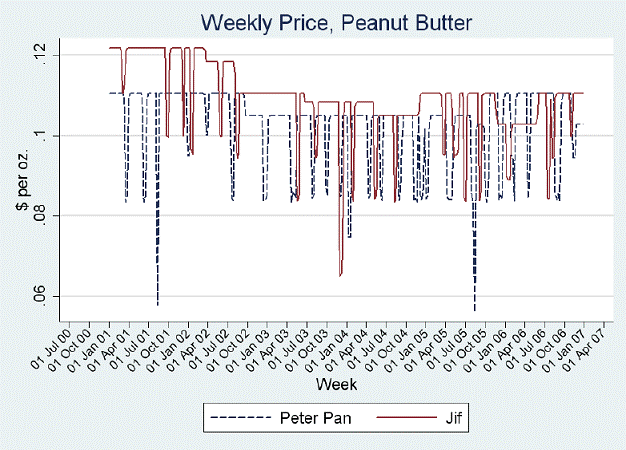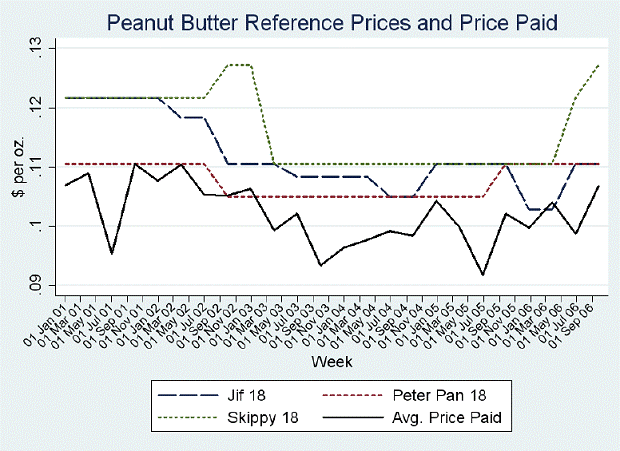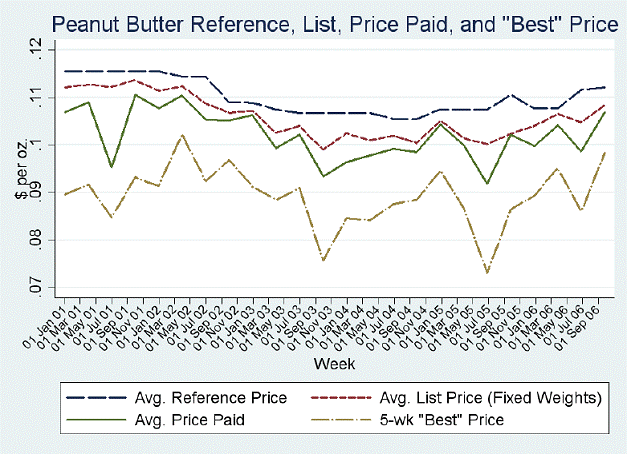A dominant class of economic theories is built on the assumption that prices respond only sluggishly to new economic conditions. It’s an interesting challenge to try to reconcile that premise with what we see in the data.
A number of research papers have now tried to describe the actual high-frequency dynamics of the prices of individual grocery items as reflected in scanner data. One of my favorites is a new paper by Yale professor Judith Chevalier and University of Chicago professor Anil Kashyap. Here’s a diagram from their paper of what one sees, for example, in the weekly price of an 18-ounce jar of Peter Pan Creamy Peanut Butter at a supermarket in northwest Chicago.
 |
That doesn’t look to me like a price that’s frozen regardless of economic conditions. Instead, one can count on periodic deep price discounts. The timing and magnitude of these is a bit hard to predict, and there’s the curious feature that, after a brief sale, the price usually goes back to exactly where it was before the sale. A paper by Eichenbaum, Jaimovich, and Rebelo suggests that perhaps the “regular” price is the object that responds sluggishly to economic conditions. It’s worth noting that in the Peter Pan graph above, the product was only on sale about one week out of five over this period. However, Chevalier and Kashyap find that these sales account for almost 40% of the ounces sold. For other products, the importance of sales is even more dramatic. For example, 12-ounce cans of Minute Maid frozen orange juice are on sale in 30% of the weeks, but those weeks account for 70% of the ounces sold.
And, even though Peter Pan might not be on sale at any given time you show up at the grocery store, its competitor Jif might be.
 |
I found Figure 3 below particularly interesting. The red, short-dashed line is the regular, non-sale price for Peter Pan that one would infer from Figure 1 above. The blue, long-dashed line is the regular price for Jif from Figure 2, and the green, short-dashed line is the regular price for a third brand. The solid black line is the average price consumers actually paid for peanut butter. Its dynamic behavior looks nothing like any of the three regular prices.
 |
So if we wanted to talk about “the” price of peanut butter, what price would we use? The diagram below gives 4 possible answers. The blue, long-dashed line is an average of the regular prices for the three brands. The red, short-dashed line is the average price you’d pay if you bought a fixed “basket” of the three brands each week, corresponding conceptually to what the consumer price index is trying to measure. Again, neither of these look much like the average price consumers actually paid for peanut butter (the solid green line).
 |
The brown, dashed-dotted line in Figure 4 is another concept that Chevalier and Kashyap suggest using, which they call the “best price.” This corresponds to how much you’d pay for peanut butter if you bought whichever brand was on sale, and were willing to stock up on special discounts to store it for up to 5 weeks. Although that extreme bargain-hunting price would by construction be lower than the actual price paid by almost everybody, the dynamic behavior of the best price resembles more closely than any of the other measures the dynamics of the average price paid actually paid by consumers.
Although prices of peanut butter may exhibit dramatic week-to-week variability, most people’s wages behave nothing like the prices of items in a grocery store. An older Keynesian tradition held that product prices were in fact perfectly flexible and that sluggish wage adjustment is the key economic friction.
But there’s obviously something much richer going on with price dynamics than what is assumed in virtually all the models that macroeconomists are using at the moment. I’m quite excited to see papers like these that examine what’s actually in the data rather than try to build a theoretical edifice whose foundation is nothing more than the imagination of economists.
Since the sales occur about every three months, and the shelf-life of highly processed peanut butter is probably close to two years, what’s surprising is that 60% of the purchases are at the 25% premium price. The peanut butter company clearly has people pretty well figured out. They capture a good chunk of the frugal shoppers and still get a premium price on most sales.
I think Amazon does this on an extreme micro-level. Prices seem to change often. I was looking for a scanner and found a name brand one for $29 on Amazon. Luckily I grabbed it because the next day it was $49. Did everyone see the $29 price? Or had I been tagged an extreme tight-wad?
A bigger problem with the use of price levels in economics is everything is adjusted via the CPI. So right now, high debtor countries like the U.S. might a little higher inflation. But higher CPI is no help at all. What’s needed is wage or income inflation. The Fed’s policies have definitely spurred growth in the CPI, but at the same time they have been detrimental to income for anyone with savings.
You mean the greenline not the solid black line when you talk of the average price consumers actually paid for peanut butter above.
Pricing is neat stuff. I suggest reading the grocery trade magazines for more because the philosophies of pricing are always a topic. There is a substantial divide between every day pricing retailers and sale pricing ones, not to mention divides with those who emphasize private labels, own labels, etc.
If you then spend time with manufacturers, you understand why they rely so much on sale pricing; in their total revenue model, they resist lowering their face price because sales occur in the range defined by that and, very importantly, they build brand awareness based on promotion. If every retailer sold at everyday pricing, the makers would lose a major marketing tool. One can of course argue that tool is somewhat of a sham but that is how the system works today.
Since I haven’t read academic work in this area, I can only say from actual experience that the real price is indeed sticky but it isn’t the so-called retail price but is a blend derived over time that includes promotions.
I’m no longer involved in this stuff but one observation is that, outside of the flour price burst we had, I’m seeing a lot more promotion and thus promotional buying. People being generally more cost aware – and many more cost-constrained – my guess is that more buying has shifted to promotional pricing, lowering what I think of as the real price.
Amen!
Greg Ransom: Thanks, I’ve made the correction.
Not to use hyperbole, but this is just awesome.
As Bob observes, the periodic discounts off regular prices seem to be a form of price discrimination to maximise revenues, not necessarily a response to changes in cost.
It could be worse. They might have used airlines tickets.
Thanks for an interesting post.
Don’t supermarkets kind of play around with their sales and their ads. Its not so much about what any one thing costs on any particular day, but how much people spend total. They may save on peanut butter a couple of cents an ounce on this day, but they chose to go to your store because of the ad, and ended up getting all of their groceries at that store. From this non-economist, this just sounds like something coming out to discount all complaints about food inflation . . . “There is no actual food inflation, people should only buy their food when its on sale.”
Yep, price discrimination is a good bet here. On the assumption that price discrimination efforts are widespread (I think they are, but maybe that’s just confirmation bias), then we’d need to figure out a way to integrate that fact into our thinking on prices. Is the average price over a period of time a good representation of business response to changing supply and demand conditions? The stability of the “normal” price is certainly not something to ignore.
Get those ABDs busy!
it’s pretty easy actually to get the cheapest price at supermarkets in the US – assuming you know which one tends to price cheaply – the sort of “extreme” bargain hunting described in the post is actually not too hard to do.
also, most peanut butters that are commercially made taste pretty much the same.
it would be interesting to compare the more “real” sort of peanut butter buying with the commercial stuff. My guess is there will be much more stickiness – those who really like peanut butter will be willing to tolerate moderate swings in prices.
JDH wrote:
I’m quite excited to see papers like these that examine what’s actually in the data rather than try to build a theoretical edifice whose foundation is nothing more than the imagination of economists.
Professor,
It is this kind of attitude that allows you to escapte the pack and keeps you on the cutting edge.
Thank you.
Great post, by the way.
I second Ricardo’s comment. Economics is hard because of the difficulty of analyzing an incredible welter of forces, with intelligent actors in the mix.
I’ll bet those down spikes in peanut butter price don’t coincide with those of jelly and bread. Not at the same store anyway. Where I live we see even larger price swings in fresh produce. Salad gets a lot cheaper if you’re not picky about what’s in it.
FYI: one of the data sets used in this paper is the IRI Marketing Data Set,which provides 7 years of data on 30 categories at store week level (over 70 gig). It’s for academic use only. For more information see my blog http://mikekr.blogspot.com/2009/07/iri-marketing-data-set-one-year.html or the IRI site http://symphonyiri.com/Academics/tabid/172/Default.aspx
Thanks – this was very interesting.
On another related topic:
I have seen repeated comments by economists that there is no reason to fear inflation and that my own fears are totally irrational. Economists have emphasized that all evidence suggests that “Shadow Stats” is completely wrong regarding inflation and that inflation is really not a problem.
Can some of you economists (I know there are many extremely knowledgeable people who post here) please comment on today’s news from Associated Press
http://www.clickorlando.com/money/27259861/detail.html#
Apologies that this even if this is related it is obvioulsy a little off topic…
Thanks again for a great blog!
dunkelblau, it’s hard to find a week in which there is not some bread brand, and some jam/jelly/preserves brand, with a downward price spike at a hi/lo chain (such as Safeway or Kroger).
Produce is interesting at hi/lo chains because the quality is substantially better at lower prices for items such as grapes — they are fresher at 0.99/lb than they are at 2.99/lb since at 2.99/lb the movement is much, much slower.
I would also expect some inventory management going on. Supply chains are most efficient at an even rate. Many consumers would also be capital/income/space limited as to how much inventory they are able and willing to stock.
“A dominant class of economic theories is built on the assumption that prices respond only sluggishly to new economic conditions”
Dr. Hamilton, its unfortunate, that the data set you graphed, 2000-2006 does not include the recent period since 2008 where massive unemployment and energy related erosion of discretionary income might affect pricing policy.
I would add, that the pricing policies of premium peanut butters and their retailers is relatively sophisticated. It took many moons for those traders to figure out the method to maximize profits through periodic brief discounting. Because of time lag, the cost of data analysis, and the time to change corporate pricing policy, it is indeed true that peanut butter pricing policy probably changes very slowly… There just isn’t enough money in the product to respond quickly like other volume consumer products.
Jeremy:The higher food and oil price squeeze is on everyone that commutes long distances. People living in extreme rural areas might have to do what their great-grandparents did and order food and tools mail-order and pick up their goods once every six weeks. People in outlying ‘berbs may have to car-pool or take (god forbid) public transportation to work. Others, not enamored by these choices, may opt to move back into central cities.
I’m a skippy fan myself. Those deep discounts are back-to-school sales. The pattern doesn’t say “prices fluctuate” so much as it says to me “there is a regular pattern of sale prices.” And what about coupons? Did they include the prevalence of coupons in the Sunday circulars? In my class, I use the big coupon ads Skippy printed in the newspaper itself in response to the salmonella-in-peanut-paste panic a couple of years ago as an example of a price movement in response to economic conditions — but notice that they “lowered the price” not by lowering the price but by offering coupon-clippers 50 cents off.
I fell out of my chair when I saw this blog post. This is the topic of my dissertation and I assumed it was uninteresting to all but 0.1% of economists. Please pardon me if this seems like a plug for my research. I rarely have an opportunity to contribute something useful to these conversations.
I too wanted to see what is going on in the data (rather than what I could model). I’m using the IRI research data set mentioned by zbcyclist.
My preliminary results suggest that “sales” are an empirically relevant margin for aggregate price adjustment. Specifically:
1) Most of the time variation in average price paid is due to “sales”
2) Stores have more “sales” following an unusually large drop in revenue
3) Between April 2001 and March 2003, personal income growth was well below trend. During this time period, the component of the CPI for which I have data grew about 2.6 percentage points while an index of average price paid fell by about 2 percentage points.
Because lots of transactions happen at sale prices, the CPI doesn’t fully reflect movements in average price paid caused by sales.
I think my results suggest that temporary price reductions are relevant for macroeconomics. I can’t wait to get my hands on scanner data from 2007 to 2010.
I must be one of those premium shoppers. I only buy one brand of peanut butter, Crazy Richard’s, because it has no salt, no sugar, no HFCS, no hydrogenated oils or trans fats. I also only buy Bonne Maman preserves for the same reason. We figure we save money in the long run by eating healthy now.
It appears to me that recently the sale price of the products I buy (and I buy these products ONLY when they are on sale) has not been as low as in previous months. This has been noticeable to me with bread, soups, macaroni and rice.
does the research show how common the peanut butter case is–i.e., is this the norm or exception for prices of most grocery items?
The store I shop at (Shaws in Boston) puts stuff on sale all the time. But it doesn’t look much like figure 1, where the sale price is usually the same. Rather, a 2.99 item will be on sale for 2.19, then back to regular price, then on sale for 2.79. Sometimes I even see it “on sale” for 2.99! I figured an important purpose was to collect data to estimate the demand curve.
Also, these discounts are only available with a frequent shopper card, which allows them to build a more sophisticated model: do people stock up when it’s cheap, then buy less later? Do they try a new brand when it’s on sale, and perhaps permanently adopt that brand? Are they substituting from a different purchase, or actually increasing their total spent?
All that information has value, in enabling the store to set a profit-maximizing price.
I remember professor Chan discussing the concept of price stickiness. I think it makes sense in durable goods (the examples he used). Having been very close to the Perishable Agricultural Commodities sector for the past 15 years, I do not believe the theory applies (at least at the wholesale level). For example, the price of a box of Mexican tomatoes in SoCal vacilated between $8 and $28 in a matter of 2 weeks. I cannot even describe the vast price volatility of carnations. The chart looked like a richter scale during an earthquake. If you look at the USDA prices at hubs(marketnews.usda.gov/protal/fv), you will see amazing price volatility on at least weekly basis. Supermarkets are a bad example because they intentionally manipulate pricing. They require long term contracts from growers for produce at fixed prices. (Very Sticky) Then, they vary the retail price due to their marketing plans. (See, PMA.com) I do not know, but I will bet that the supermarket paid the same price for the peanut butter for a 12 month period and manipulatied the retail price to further some other plan.